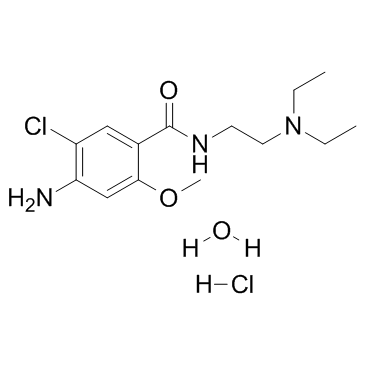All AbMole products are for research use only, cannot be used for human consumption.

Metoclopramide hydrochloride hydrate is a dopamine D2 antagonist that is used as an antiemetic. Metoclopramide is a dopamine receptor antagonist which has been used for treatment of a variety of gastrointestinal symptoms over the last thirty years. In various countries, metoclopramide is the antiemetic drug of choice in pregnant women. Findings provide reassurance regarding the safety of metoclopramide for the fetus when the drug is given to women to relieve nausea and vomiting during pregnancy. Evidence also supports its use for gastroparesis (poor stomach emptying) and gastroesophageal reflux disease. It appears to bind to dopamine D2 receptors where it is a receptor antagonist, and is also a mixed 5-HT3 receptor antagonist/ 5-HT4 receptor agonist. It can be used to construct animal models of hyperprolactinemia.
| Cell Experiment | |
|---|---|
| Cell lines | |
| Preparation method | |
| Concentrations | |
| Incubation time | |
| Animal Experiment | |
|---|---|
| Animal models | Male albino Swiss mice |
| Formulation | saline solution |
| Dosages | 20 mg/kg |
| Administration | i.p. |
| Molecular Weight | 354.27 |
| Formula | C14H25Cl2N3O3 |
| CAS Number | 54143-57-6 |
| Solubility (25°C) | 10 mM in DMSO |
| Storage |
Powder -20°C 3 years ; 4°C 2 years In solvent -80°C 6 months ; -20°C 1 month |
| Related Animal Modeling Products |
|---|
| 3,4-Benzopyrene
3,4-Benzopyrene shows lung carcinogenicity in animal models. |
| Sodium Thioglycolate
Sodium thioglycolate acts as reducing agent and is suitable for anaerobic and microaerophilic bacterial growth. Sodium thioglycolate is a commonly used reagent for bacteriological research to maintain reducing conditions in media. Thioglycolate can also protect enzymes against inactivation by maintaining protein thiol groups in the reduced state. Thioglycolate medium is frequently used in inflammation research to elicit a neutrophil and macrophage response in vivo. |
| Vancomycin-d10 2TFA salt
Vancomycin-d10 2TFA salt |
| Acetic acid-d4
Acetic acid-d4 |
| Myosin H Chain Fragment, mouse acetate
Myosin H Chain Fragment, mouse acetate salt is a fragment of the α-Myosin heavy chain peptide. Myosin H Chain Fragment can be used to induce experimental autoimmune myocarditis (EAM) mouse model. |
All AbMole products are for research use only, cannot be used for human consumption or veterinary use. We do not provide products or services to individuals. Please comply with the intended use and do not use AbMole products for any other purpose.


Products are for research use only. Not for human use. We do not sell to patients.
© Copyright 2010-2024 AbMole BioScience. All Rights Reserved.
